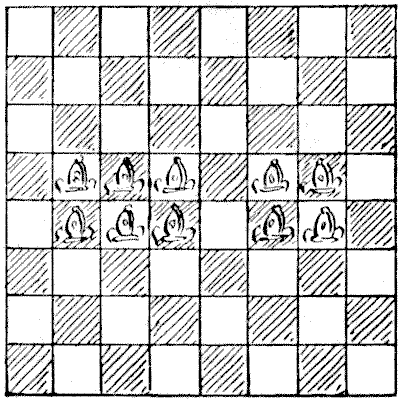(related to Problem: Bishops — guarded)
This puzzle is quite easy if you, first of all, give it a little thought. You need only consider squares of one color, for whatever can be done in the case of the white squares can always be repeated on the black, and they are here quite independent of one another. This equality, of course, is in consequence of the fact that the number of squares on an ordinary chessboard, sixty-four, is an even number. If a square chequered board has an odd number of squares, then there will always be one more square of one color than of the other.

Ten bishops are necessary in order that every square shall be attacked and every bishop guarded by another bishop. I give one way of arranging them in the diagram. It will be noticed that the two central bishops in the group of six on the left-hand side of the board serve no purpose, except to protect those bishops that are on adjoining squares. Another solution would, therefore, be obtained by simply raising the upper one of these one square and placing the other a square lower down.
This eBook is for the use of anyone anywhere in the United States and most other parts of the world at no cost and with almost no restrictions whatsoever. You may copy it, give it away or re-use it under the terms of the Project Gutenberg License included with this edition or online at http://www.gutenberg.org. If you are not located in the United States, you'll have to check the laws of the country where you are located before using this ebook.